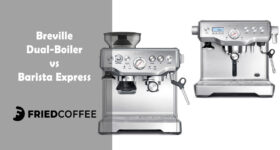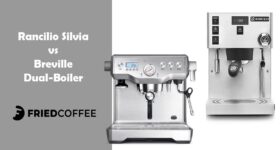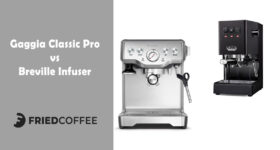
Are you stuck at home and thinking of ways to spend your time? Why not become a home barista? Staying at home during the pandemic has given many the opportunity to hone their home-brewing skills. Therefore, we decided to help you by breaking down the differences between two popular ways of brewing at home – the immersion method with a French Press and the pour-over method. We are going to explore how these methods differ with regard to flavor, grind, and brew ratio. What’s more, we will present a recipe for each method and give you some extra tips and tricks to perfect your brew. So get ready!
French Press vs Pour Over – The Main Difference
Let’s start by understanding the main difference between the immersion method and the pour-over method. It simply has to do with the way the hot water touches the coffee grounds in your brewer. As its name suggests, the immersion method occurs when the coffee grounds are immersed, that is covered completely, by the hot water. The coffee grounds are then left to steep so that the hot water will extract the coffee. This is one of the earliest brewing methods dating back to the 19th century. One of the most common ways to brew using the immersion method is with the French Press.
The pour-over method is a more modern method of brewing coffee at home. In contrast to the immersion method, the hot water is slowly poured-over the coffee grounds in different stages ideally while using a timer. This method exercises more control over the brew and is preferred by many for its precision. When brewing with a pour-over device, your cup of coffee will be clear and bright while enhancing the flavors of the coffee beans at the same time. That differs when you’re using the immersion method, which results in a heavy cup, with more body and possibly sediment.
Pour Over vs French Press – The Equipment
Both methods are widely popular worldwide and there are a few brewers in the market which you can use for applying them. The most popular immersion method brewers are the French Press, the Aeropress, and the Clever Dripper.
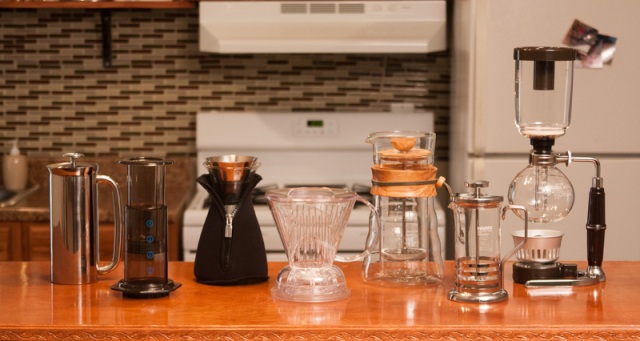
French Press is the oldest and most common out of the three. It’s reliable and much loved by many households, so we have prepared a recipe for you to make at home.
The most popular pour-over methods currently in the market are the V60, the Chemex, and the Kalita Wave. For the purpose of comparing it with the French Press, we will give you a V60 recipe.
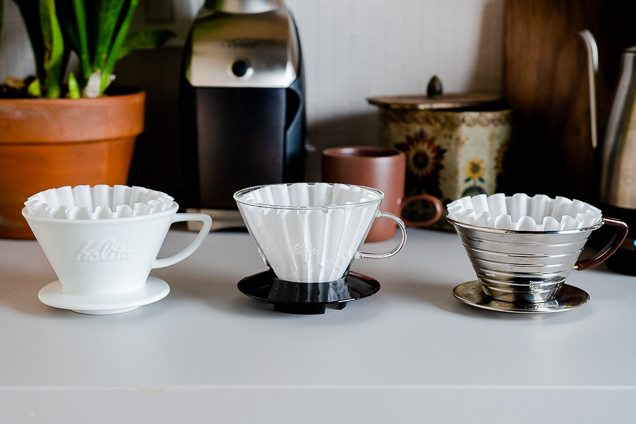
Grind Size and Brew Ratio
The two most important variables you need to be aware of when brewing coffee at home, are the grind size and the brew ratio. Both these variables will affect the final result, so paying attention to them will help you brew a delicious cup of coffee.
French Press Brew Ratio and Grind Size
Depending on which size of the French Press you own, the brew ratio will vary. One of the most popular sizes is the 3-cup French Press, with a ratio of 1:16. This means that you need 27g of coffee and 430ml of water. Once you know how many grams of coffee beans you need to use, it’s time to grind them. We advise grinding the beans using a coarse grind setting when you’re brewing with a French Press.
As we mentioned above, the French Press is an immersion brewing method, which means that the hot water will cover grounds, which will in turn steep in it. By grinding coarse you will slow down the extraction process by giving the grounds a flat shape. If you choose a medium-fine grind setting, then you might over-extract the coffee which will result in a tangy and bitter flavor profile in your cup.
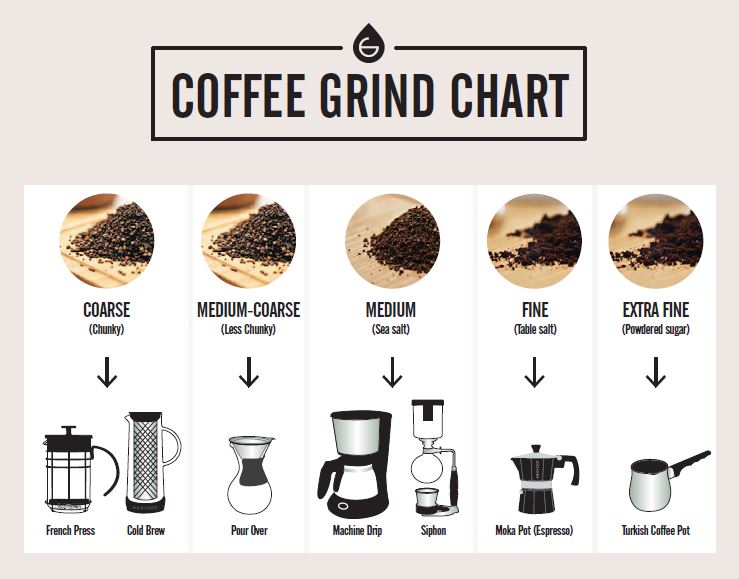
Pour-over Brew Ratio and Grind Size
Much like the French Press, the brew ratio for any pour-over method varies depending on which brewer you are using (V60, Kalita Wave, Chemex, etc.), the size of the brewer, and the number of cups you wish to make. Basically, the more cups you want to make, the more coffee you will need and this prolongs the brew time. For the purpose of this comparison let’s say you would like to make a 1-cup V60. We advise you to use a brew ratio of 1:18, which is 14g of coffee beans and 250ml of water.
Regarding the grind setting for pour-over methods, you actually have a chance to experiment. Whether you are using a V60, a Kalita Wave, or a Chemex, the way you grind your coffee beans will result in a different cup of coffee. If you grind the beans fine, then the water will have a hard time going through the coffee grounds and this will result in a heavy, full-bodied flavor. If you grind coarse, the water will go through the bed of coffee faster and your cup’s flavor will be clean and bright.
Tips and Tricks Before you Begin
We’ve compiled a few extra tips and tricks that you can consider before you start brewing:
Grinding fresh: We strongly advise that you buy coffee beans and not pre-ground coffee. Investing in a good coffee grinder will bring your home brewing to another level, as your ground coffee will be fresh. This helps avoid any stale flavors in your cup but it also lets you decide what kind of grind size you would like to use.
Water temperature & quality: Most of what you have in your cup of coffee is water, so it would only make sense that the water quality plays a factor in the flavor profile of your cup. If you can, we advise that you use filter water for your brew. Regarding temperature, go for somewhere between 85-95°C. Never boil the water as it will be too hot and it will make your coffee taste bitter.
Filters: The French Press has a metal filter but some pour-over methods come with either paper or metal filters. Choosing between the two will affect the flavor of your coffee. The metal filter isn’t able to absorb the natural oils of the coffee, which end up in your cup. This will make the coffee heavier and you might find sediment in your cup. The paper filters on the other hand have the ability to absorb the oils and result in a clean, bright cup.
Preheating: This step is important for ensuring your cup of coffee has the ideal temperature. It is advisable to preheat your brewer, your cup, and your filters before you start brewing. Preheating the brewer will ensure that the temperature of the hot water won’t drop when you start pouring it. If you preheat your mug, your coffee won’t drop in temperature when you pour it in. Finally, you can avoid any papery flavors if you preheat the paper filters.
Agitation: Another big part of the brewing process is agitation. Some people prefer to do it and some don’t. In general, when you have added some water during brewing, it’s a good idea to agitate the brew, meaning you should try to stir the coffee grounds. This will allow all the coffee grounds to mix with the water more evenly and your brew will be more consistent.
Kettle style: Last but not least, if you’re serious about precision, you might want to invest in a pour-over gooseneck kettle. These feature a curvy and long spout, which helps you improve the accuracy and the speed of your pouring as compared to basic electric kettles.
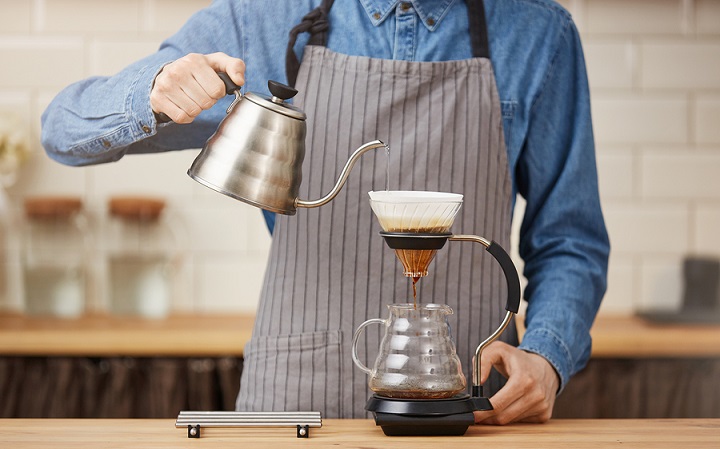
How to Brew with a French Press
For 3-cups you will need
A French Press, scale, 27g of whole coffee beans, a timer, a coffee grinder, 430 ml of filtered water plus additional for preheating your cups and spoon or stirrer
Instructions
Grind the beans using a coarse grind setting. Use some of the hot water to preheat the French Press, pour it out, and add the coffee grounds in. Shake the French Press gently to even the grounds out. Place the French Press on your scales, start the timer and begin pouring half of the hot water. Once half a minute has passed, break up the crust of the coffee grounds with a stirrer or a spoon.
Pour in the remaining hot water and place the lid on the French Press without plunging down yet. Let the coffee grounds steep for 4 minutes, then plunge down and serve your coffee immediately. Try not to let the coffee sit in the French Press for long. This will lead to over-extraction and a bitter flavor. If you won’t want to drink it straight away, pour it into another preheated vessel so that the grounds are separated from the brew.
How to Brew with a Pour Over V60
For 1-cup you will need
A V60, filters, coffee scale, 14g of whole coffee beans, a timer, a coffee grinder, 250 ml of filtered water plus additional for preheating your cup and spoon or stirrer
Instructions
Grind the beans using your preferred grind setting, we recommend medium-coarse for a clean cup. Place V60 on top of your mug and put the filter in the V60. This way when you add some hot water it will preheat the brewer, the filter, and your mug at the same time. Pour out the hot water in your mug and add the coffee grounds in the V60. Place the V60 back on your mug and your mug on the scales.
Start the timer and begin pouring. For the first pour add double the amount of water to coffee. This step is called the bloom. Let it bloom for about 30 seconds and continue pouring until you reach 250ml in 2:30 minutes. You can stir whenever you feel it’s necessary if you notice that some grounds aren’t in contact with the water. Remove your mug and the V60 from the scales and enjoy your coffee.
Maintenance Tips & Buying Guide
Whilst most pour-over methods are easy to clean, the French Press needs a bit of extra effort. Sometimes the coffee grounds get stuck in the metal filter. If you won’t wash it carefully the next time you brew with it, your coffee might end up not tasting as fresh. Thankfully, it’s easy to take the filter out and clean it separately. Additionally, you might want to try and use your French Press for different purposes like frothing milk, brewing tea, or even mixing cocktails. Again it’s important to ensure it’s properly cleaned after every use.
Regarding their value, both the French Press and the pour-over methods will vary in cost. In general, you are looking at spending 20-100 USD depending on the style and size of the brewer. The French Press comes in different sizes but also in different materials and so do the pour-over brewers as well. You will have to consider a few material options such as ceramic, copper, stainless steel, glass, and plastic. Some materials are better for heat retention than others, e.g. stainless steel. Here is our guide to the best Pour-over coffee makers! Go through it if you are interested in that.
Final Thoughts
We hope that today’s article has helped you gain a better understanding of how to use a French Press and pour-over methods. You have probably noticed yourself that there are a few variables you can experiment with during brewing. Whatever you choose to do, keep in mind that there isn’t one way of brewing coffee. You can play around with different brewing methods, various coffee beans, ratio, grind size, etc. You might discover that you like some brewing methods more than others. What’s important is that you have many options of enjoying a cup of coffee and discovering what your favorite one is can be really fun. Stay home and stay safe.
